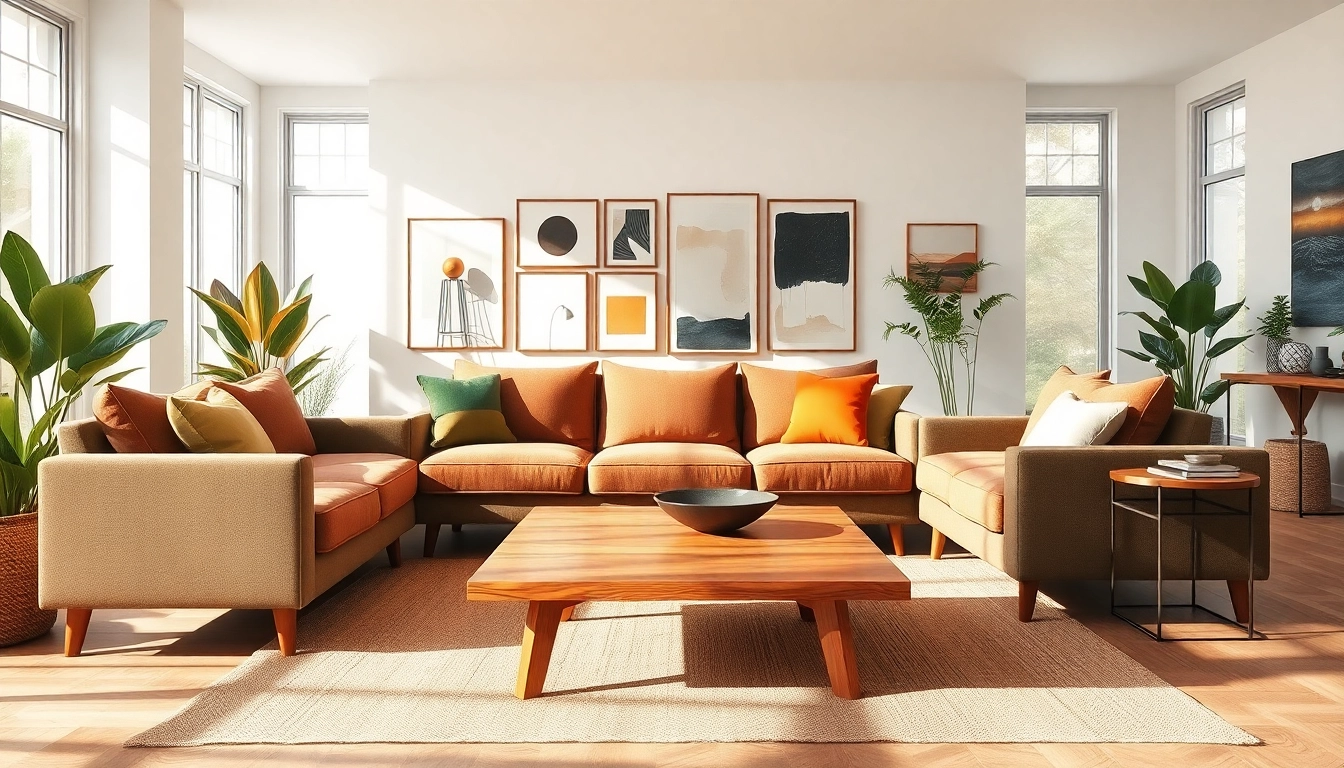Understanding MCM Home Decor: A Brief Introduction
Mid-Century Modern Home Decor, commonly referred to as MCM Home Decor, is not just a design style; it’s a cultural phenomenon that has deeply influenced interior design. Originating in the mid-20th century, it represents the aesthetics and sensibilities of an era filled with optimism and innovation. Characterized by clean lines, organic forms, and an emphasis on function, MCM decor has stood the test of time, becoming a staple in homes that value both beauty and usability.
What Defines Mid-Century Modern Style?
Mid-Century Modern style emerged in the United States during the 1940s to late 1960s, influenced by the technological advances following World War II, a burgeoning appreciation for nature, and a progressive shift in social values. This style is marked by its rejection of the ornamental excesses of previous design eras and instead embraces simplicity and functionality. Key attributes include:
- Simplicity: Clean lines and minimalism are central to MCM, promoting a clutter-free environment.
- Functionality: Every design element serves a purpose, which reflects the ethos of “form follows function.”
- Organic Shapes: MCM incorporates curvilinear forms that mimic natural landscapes.
- Integration with Nature: Large windows and open spaces create a seamless transition between indoor and outdoor living.
Key Characteristics of MCM Home Decor
The hallmark features of Mid-Century Modern decor can be distilled into several key characteristics:
- Bold Colors: From avocado greens and mustard yellows to earthy browns, the color palette is both vibrant and earthy.
- Mix of Materials: Wood, metal, glass, and plastic often blend together creating a sophisticated and interesting aesthetic.
- Iconic Furniture Design: Think of pieces designed by legends like Charles and Ray Eames, Eero Saarinen, and George Nelson — furniture that is both art and utility.
- Geometric Patterns: Inspired by nature, but executed in a way that complements the clean lines, patterns often emerge in textiles, wallpapers, and rugs.
Historical Influences on MCM Design
The historical context of MCM influences its aesthetics profoundly. This style capitalized on the post-war societal evolution— a time when people were moving into suburbs, and there was a growing interest in designs that could provide functionality while remaining stylish. The influence of international design movements, particularly Scandinavian and Bauhaus, is evident in MCM. Designers adapted these concepts to American sensibilities, emphasizing simplicity, democratic design, and mass production. The introduction of new materials like molded plywood and fiberglass made it possible to create iconic pieces that were both accessible and appealing.
Essential Elements of MCM Home Decor
Iconic Furniture Pieces for Your Home
When it comes to furnishing an MCM space, certain pieces have become emblematic of the style. Key furniture items include:
- Eames Lounge Chair: This chair is perhaps the most celebrated piece of MCM furniture, combining comfort and unmatched aesthetic appeal.
- Noguchi Table: A sculptural coffee table that embodies MCM’s integration of art and functionality.
- Saarinen Tulip Table: Known for its sinuous form, this table represents the seamless blend of modern design and practicality.
- Teak Credenzas: Often featuring sliding doors, these sideboards provide storage while showcasing the warmth of natural wood.
Color Schemes in MCM Interiors
MCM homes utilize an eclectic mix of colors that evoke a sense of playfulness while still maintaining harmony. The typical color palette includes:
- Earthy Tones: Rich browns, deep greens, and warm yellows create a cozy yet stylish atmosphere.
- Accent Colors: Splashes of bold pastels or primaries can be introduced through artwork, decor, or textiles to enliven the space.
- Neutral Bases: Soft beiges, whites, and grays often serve as a backdrop, allowing the vibrant tones to pop without overwhelming the senses.
Incorporating Natural Materials
One of the defining principles of MCM design is its embrace of natural materials. Unlike the synthetic finishes that predominate contemporary design, MCM favors the tactile feel of wood, leather, and stone. Common materials include:
- Wood: Dark woods like walnut and lighter options like birch create a contrast that is visually appealing.
- Leather: Often used in furniture upholstery, leather adds a sense of luxury and comfort.
- Glass: Large windows and glass table tops enhance light and create an openness that aligns with MCM philosophies.
How to Decorate with MCM Aesthetics
Room-by-Room MCM Styling Tips
Creating a cohesive MCM aesthetic throughout your home requires thoughtful design decisions tailored to each room:
- Living Room: Center a statement piece like an Eames Lounge Chair and pair it with a minimalist sofa; softness can be introduced with geometric throw pillows.
- Dining Room: Utilize a sleek tulip table accompanied by molded chairs, accentuating the beauty of natural wood through a statement credenza.
- Bedroom: Focus on simplicity; opt for a low-profile bed frame made of natural wood, complemented by a geometric-patterned duvet cover.
- Office: Bring in functional storage solutions like a wall-mounted desk or a floating shelf to maintain an uncluttered workspace.
Balancing Functionality and Form
In MCM decor, achieving the perfect balance between aesthetics and function is key. When choosing pieces, ensure that each one serves a purpose while also enhancing the visual ensemble. For instance, opt for furniture with hidden storage compartments, or select decorative items that can be easily brought into functionality, such as a stylish storage basket that doubles as decor.
Combining MCM with Other Styles
Despite its distinctive identity, MCM can harmoniously coexist with various other design styles. Here are some effective combinations:
- Scandinavian: The minimalism of Scandinavian decor complements MCM’s clean lines, creating an effortlessly chic environment.
- Industrial: Mixing rusted metal accents with MCM wood pieces adds a refreshing contrast, maintaining warmth while introducing an edginess.
- Bohemian: Incorporating bohemian elements like succulents, textiles, and colorful art can bring vibrancy into an MCM environment, perfect for personalized touches.
Modern Trends in MCM Home Decor
Reviving Vintage Finds
The sustainability movement has given rise to an increasing appreciation for vintage furniture. Shopping at thrift stores and flea markets can yield Savanah pieces that embody the charm and artistry of MCM design. Key aspects include:
- Unique History: Vintage pieces often come with stories embedded within them, adding depth and character to decor.
- Quality Craftsmanship: Older furniture is often made from solid woods or crafted with techniques that outlast current standards.
- Personal Touch: Choosing vintage allows for a deeper connection to the items displayed in your home.
Integrating Technology with Classic Designs
The modern homeowner seeks technology that enhances home functionality without disrupting the aesthetic. Smart home devices can be seamlessly integrated, often hidden within classic designs or stylish covers that mimic wood or leather to maintain the desired aesthetic.
Sustainable Practices in MCM Decor
As the world becomes increasingly eco-conscious, incorporating sustainability into MCM decor has become a trend. From sourcing reclaimed wood for new furniture to using eco-friendly paints and finishes, there are numerous ways to achieve a stylish home while being environmentally responsible.
Where to Shop for MCM Home Decor
Top Online Retailers and Boutiques
Finding authentic MCM pieces is easier than ever with the rise of online retailers. Many websites specialize in mid-century modern furniture, providing a wide selection of both vintage and reproduced items. Sites such as Wayfair, West Elm, and CB2 offer accessible price points while still ensuring authenticity in design.
Thrift Stores and Antique Shops
Local thrift stores, estate sales, and antique shops are treasure troves for anyone looking to source unique MCM pieces. The thrill of finding a bargain on a rare item adds excitement to the search.
Custom Pieces from Local Artisans
Another excellent avenue for procuring MCM home decor is by commissioning custom pieces from local artisans. These professionals can create tailored items that incorporate the quintessential elements of MCM design while reflecting personal style, ensuring that your interior decor is one-of-a-kind.



